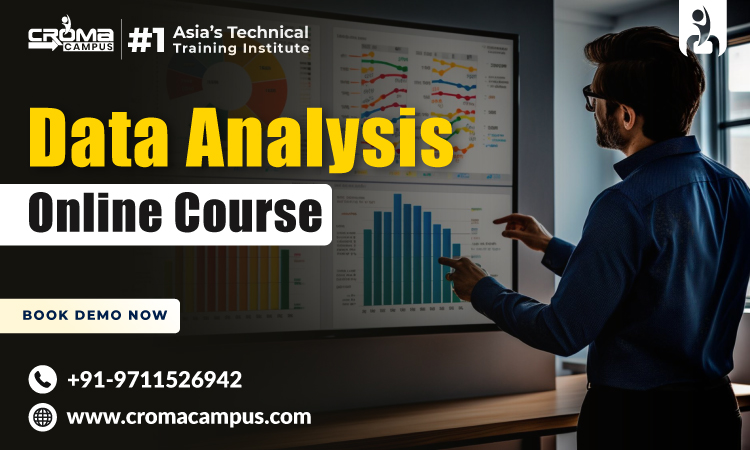Introduction
After enrolling in the Data Analysis Online Course, you will learn about Exploratory Data Analysis (EDA) in the context of data cleaning, preparation, and understanding. After the course completion, you will have a solid understanding of EDA techniques. Here are the key aspects that will be covered in the Data Analysis course.
Data Cleaning and Preparation:
-
Handling missing values- You will be able to learn techniques such as imputation, deletion, or replacing missing values.
-
Outlier detection and handling- Will be able to identify and address the outliers that can skew data analysis.
-
Data normalization and standardization- This refers to the process of transforming the data into a consistent format for analysis.
-
Feature engineering- This includes the practice of creating new features from existing ones to improve the model performance.
Data Visualization:
-
Creating various plots- This includes the practice of using libraries like Matplotlib, Seaborn, or Plotly to visualize data.
-
Choosing appropriate visualizations- Here you will learn how to choose the best visualization techniques for different data and questions.
-
Interpreting visualizations- You will also be able to draw insights and conclusions from the visualizations.
Statistical Analysis:
-
Descriptive statistics- It includes calculating the summary statistics like mean, median, and mode.
-
Correlation analysis- This practice is for measuring the strength and direction of relationships between variables.
-
Hypothesis testing- It is useful for evaluating the hypotheses about the data using statistical tests.
Data Exploration and Insights:
-
Discovering patterns and trends- The course will teach you how to identify the patterns, and trends within the data.
-
Understanding data relationships- You will also be able to explore how different variables are related to each other.
-
Generating hypotheses- This approach will help you formulate the hypotheses as per the insights gained from EDA.
EDA Tools and Techniques:
-
Using Python libraries- You will be able to leverage libraries like NumPy, Pandas, Matplotlib, and Seaborn for EDA tasks.
-
Working with different data formats- The course will help you handle various data formats like CSV, JSON, and Excel.
-
Using interactive tools- You will be able to explore interactive data exploration tools like Jupyter Notebook.
Significant Features of EDA
Exploratory Data Analysis (EDA) is a crucial step in the data science process. This step consists of summarizing and understanding data using statistical and visualization techniques. The primary objective of the EDA process is to recognize the patterns, trends, and anomalies within the data. To further know about it, one can visit the Data Analysis Online Course. Now let’s have a look at the key objectives of EDA:
-
Understanding data distribution- It is useful for analyzing the frequency and distribution of values within a dataset.
-
Identifying outliers- This solution is useful for detecting unusual or unexpected data points.
-
Discovering relationships- It helps in exploring the relationships between variables within the data.
-
Visualizing data- It uses charts and graphs to represent data in a visually understandable way.
-
Generating hypotheses- This refers to the practice of formulating hypotheses as per the insights gained from EDA.
Common EDA Techniques
The EDA refers to an iterative process that includes exploring the data, gaining insights, and refining the analysis as needed. In addition, it is a necessary step in the data science projects useful for conducting the analysis and modelling. The Data Analyst Course Fees is around 30,000 to 40,000 INR and enrolling in them can help you learn the EDA Techniques. Here are the most popular and common kinds of EDA techniques used by businesses.
-
Descriptive statistics- It refers to the practice of calculating summary statistics like mean, median, mode, standard deviation, and quartiles.
-
Data visualization- This approach is useful for creating plots, charts, and histograms to visualize data distribution and relationships.
-
Correlation analysis- It refers to the practice of measuring the strength and direction of relationships between variables.
-
Hypothesis Testing- The hypothesis testing process includes evaluating the hypotheses about the data using statistical tests.
What are the Benefits of Using EDA?
Using the EDA is a necessary and crucial step in the data science process. Implementing EDA in business provides valuable insights, improves data quality, and also supports effective decision-making. Along with this, it enhances the understanding of your data, including its distribution, relationships, and potential outliers. Apart from these, given below are the benefits of using EDA.
-
Improved Data Quality- Using EDA helps in addressing data quality issues such as missing values, inconsistencies, and errors.
-
Hypothesis Generation- It is useful for generating hypotheses that can be further tested through statistical analysis.
-
Feature Engineering- It understands the data and creates new features that may improve the performance of your models.
-
Visualization- The EDA is useful for visualizing the data in an easy-to-communicate way.
-
Decision Making- Using EDA helps businesses in getting valuable insights that can inform decision-making and problem-solving.
-
Model Building- It provides a solid understanding of Data and helps in building effective machine-learning models.
Conclusion
Exploratory Data Analysis (EDA) is a crucial step in the data science process. It includes summarizing, understanding, and visualizing data to gain insights and inform decision-making. By mastering the EDA techniques, you can effectively clean, prepare, and explore your data. Thus, resulting in leading to improved data quality, hypothesis generation, and model building.

